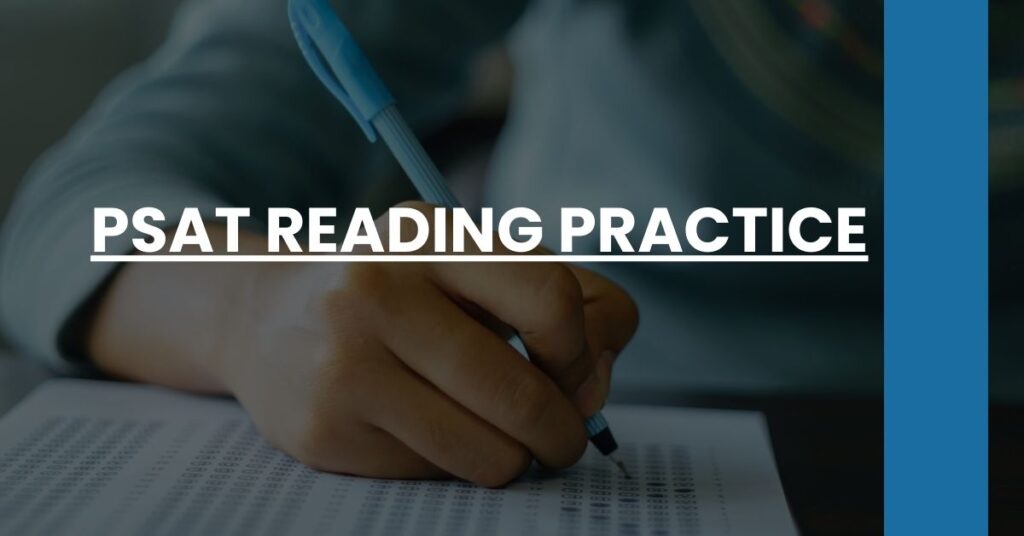PSAT Reading Practice can elevate your test scores and comprehension skills.
- Effective Strategies for PSAT Reading Practice: Learn methods to quickly identify themes and answer questions accurately.
- Regular PSAT Reading Practice: Discover the importance of consistency and how it improves your overall reading abilities.
- Resources for PSAT Reading Practice: Utilize a variety of materials, from official practice tests to online platforms, for targeted preparation.
Achieve mastery in PSAT reading practice with these actionable steps.
- Why PSAT Reading Practice is Crucial
- Understanding the PSAT Reading Section
- Resources for PSAT Reading Practice
- Developing a PSAT Reading Study Plan
- Strategies for PSAT Reading Success
- Common Challenges in PSAT Reading
- The Importance of Reading Beyond Practice Tests
- Analyzing PSAT Reading Answer Choices
- Real Testimonials and Success Stories
- Conclusion
Why PSAT Reading Practice is Crucial
Regular practice for the PSAT reading section has a slew of benefits that extend beyond the score on your test – it’s about building a strong foundation for future academic and professional success. Here’s why practicing for the PSAT reading section should be a non-negotiable part of your test prep routine:
- Enhances Comprehension: Regular reading and test practice can dramatically boost your ability to understand complex texts – an essential skill for college and beyond.
- Expands Vocabulary: The more you read, the more words you’re exposed to, and this can significantly help with the sentence completion and passage-based questions on the PSAT.
- Develops Critical Thinking: Critical reading means not just understanding what the text says but analyzing what it means – a critical skill for the evidence-based reading questions you’ll encounter.
- Times Management Skills: As you practice, you’ll learn how much time to spend on each question and how to avoid common time-wasting traps.
Incorporating PSAT reading practice into your study schedule can be transformative. It’s not just about the score; it’s about shaping your academic future.
Understanding the PSAT Reading Section
Before diving into practice, it’s crucial to understand what the PSAT reading section entails. This part of the test calls on your ability to read critically, interpret data, and understand vocabulary and context.
Types of Passages
You’ll encounter a variety of passages:
- Literature: Excerpts from classic and contemporary works that test your ability to grasp themes and character development.
- Social Studies and History: Passages that check your understanding of argumentation and evidence-based reasoning.
- Science: These require you to interpret data and understand the scientific method.
Question Formats
Questions generally fall into these categories:
- Questions about specific details
- Inferences and conclusions
- Vocabulary in context
- Overall themes and ideas
Scoring Savvy
It’s a points game – answer correctly, and you earn points, but incorrect answers don’t count against you. So, it’s worth taking an educated guess if you’re unsure.
Resources for PSAT Reading Practice
Quality practice resources are gold when preparing for the PSAT reading section. Here are some you should definitely consider:
- Official Practice Tests: The College Board offers free, official PSAT practice tests, providing the most realistic preparation experience.
- Study Books: Comprehensive guides offer strategies and additional practice questions.
- Online Platforms: Websites and apps offer interactive ways to engage with PSAT materials, including instant feedback and adaptive learning.
Popular resources for reading section practice include books from Princeton Review and Kaplan, as well as websites such as Khan Academy.
Developing a PSAT Reading Study Plan
Your PSAT study plan should be as unique as your learning style. Customizing it to suit your needs can make all the difference. Here’s how to construct a personalized plan:
- Frequency of Practice: Whether you’re an early bird or a night owl, find times when you can consistently engage in focused practice sessions.
- Duration of Sessions: Short, regular sessions can be more fruitful than marathon cramming.
- Milestones: Setting specific goals will provide direction and a sense of achievement as you progress.
A study plan should include a mix of practice tests, reading a variety of texts, and regular reviews of vocabulary and concepts.
Strategies for PSAT Reading Success
Conquering the PSAT reading section requires a blend of techniques tailored to the test’s demands. Being familiar with certain strategies can help ensure success:
- Skim First: Get the gist before diving in; it’ll help you know where to look back for answers.
- Evidence-Based Answers: Always look for direct support from the passage when choosing an answer.
- Elimination Process: If an answer seems wrong, it probably is – rule it out.
- Words in Context: Use surrounding words to figure out the meaning of unfamiliar vocabulary.
Above all, practice with an analytical mindset – understanding not just the ‘what’, but the ‘why’ and ‘how’ of the text. Each strategy you employ is another step toward mastery of the PSAT reading section.
Common Challenges in PSAT Reading
The PSAT reading section, while a gateway to academic growth, comes with its challenges. Many students face common hurdles that can hinder their performance unless effectively addressed. Here’s how to triumph over these obstacles and refine your psat reading practice.
Tight Time Constraints
Managing time efficiently: The clock is ticking, and you need to allocate your minutes wisely. Consider implementing time-saving techniques such as:
- Speed-reading: Hone your ability to skim through passages quickly while grasping the essential details.
- Prioritizing questions: Tackle the ones you find easiest first to secure those points before moving on to more challenging ones.
Tricky Questions and Distractors
Thwarting test traps: Some answers are designed to mislead you. Stay on your toes by:
- Attentive reading: Focus on the main ideas and supporting evidence within the passage to avoid being tripped up by tempting, but incorrect, answers.
- Analyzing all options: Before marking your answer, ensure that you have ruled out other choices by finding evidence in the passage that supports your selection.
Vocabulary Challenges
Building word power: Unfamiliar words can derail your understanding. Combat this by:
- Context clues: Use the words and sentences around the unfamiliar term to deduce its meaning.
- Regular revision: Keep a list of new words encountered during your practice and revise them frequently.
Remember, perseverance through these hurdles will enhance your psat reading practice and, consequently, your PSAT performance.
The Importance of Reading Beyond Practice Tests
Diversifying your reading material is like cross-training for your brain. Repeated exposure to a wide array of texts can fortify your psat reading practice, making you a more agile and perceptive reader.
Literature and Fiction
Through stories, expand your mind: Novels and short stories not only entertain but also build deep reading skills needed for literature passages.
- Understanding subtext and theme: These are the layers beneath what’s written that exams often probe.
Non-Fiction and News
Staying informed sharpens analysis: Articles on current events or informative non-fiction works can fine-tune your ability to deconstruct arguments – a key skill for the PSAT’s informational passages.
- Analyzing arguments and premises: Recognize the structure and strength of an author’s argument, an invaluable tool for test-day success.
Remember, by reading broadly, you’re not just preparing for the PSAT – you’re setting the stage for lifelong learning.
Analyzing PSAT Reading Answer Choices
To excel in the PSAT reading section, adopting a methodical approach to analyzing answer choices is not just beneficial – it’s necessary. Let’s explore how to dissect these choices to ensure accuracy in your responses.
Identifying Supporting Evidence
Deciphering the best answer: A correct choice is always backed by textual support, so your job is to match details from the passage with the options given.
Recognizing Nuance and Tone
Understanding subtlety: The PSAT often examines your ability to detect the author’s tone and the nuances in their argument or narrative.
- Assessing tone: Determine whether the passage’s mood is optimistic, critical, neutral, and so on, to better answer related questions.
Navigating answer choices astutely will bolster your confidence and effectiveness in your psat reading practice endeavors.
Real Testimonials and Success Stories
Real-world successes can inspire and guide your psat reading practice. These accounts act as beacons, showing that with dedication and strategic preparation, your goals are well within reach.
Personal Journeys
Learning from peer experiences: Real students often share their prep journeys, offering a wealth of tactics and encouraging anecdotes.
- Emulating effective habits: Adopt tried-and-true practices that helped others succeed.
Expert Insights
Benefiting from professional advice: Test prep experts frequently offer valuable insights based on years of experience and data analysis.
- Adopting expert strategies: Incorporate professional tips into your study plan for maximum impact.
Let these stories of triumph remind you that with the right psat reading practice, surpassing even your own expectations is possible.
Conclusion
Your journey through PSAT reading practice is a marathon, not a sprint. Take it step by step, implementing the strategies laid out above, and gradually you’ll see the fruits of your labor. Remember, consistent practice is key. With each practice session, your reading skills will sharpen, your pace will quicken, and your confidence will soar.
The PSAT is not just an assessment of your current abilities – it’s a doorway to your educational future. Embracing psat reading practice is an investment in that future. Stay determined, stay curious, and let the power of practice open doors to a world of possibilities.

